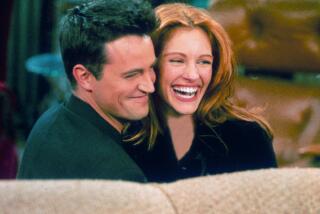Classic Hollywood: âThe Last Picture Showâ
Peter Bogdanovich recalls that his 1971 masterpiece, âThe Last Picture Show,â was a difficult shoot.
âMy father died during it suddenly of a stroke,â he reflected. Then his marriage to production designer Polly Platt fell apart after he fell in love with his leading lady, Cybill Shepherd. âAll that happened while on the picture,â Bogdanovich said. âWe all went down to Texas as one person, and we all came back different people.â
âThe Last Picture Showâ was based on Larry McMurtryâs novel about teenage friends Sonny (Timothy Bottoms) and Duane (Jeff Bridges) living in a dying Texas town in 1951. It is considered one of the seminal movies from the golden age of the 1970s along with such classics as Francis Ford Coppolaâs âGodfatherâ films and âThe Conversation,â Martin Scorseseâs âMean Streetsâ and âTaxi Driver,â and Terrence Malickâs âBadlands.â
A film historian, Bogdanovich was friends with several veteran filmmakers, including Orson Welles, John Ford and Howard Hawks, and he paid homage to his mentors with the film. He used classic country- western songs from the era, including Hank Williams tunes, and decided to shoot in black and white. Welles told Bogdanovich that the film had to be shot in this manner: âEvery performance looks better in black and white. Name a great performance in color. I dare you.â
Nominated for eight Academy Awards, including best picture, director, supporting actor for Bridges, and Robert Surteesâ cinematography, âLast Picture Showâ won Oscars for Cloris Leachman and Ben Johnson, both for supporting acting. Leachman played Ruth Popper, the lonely wife of the football coach who has an affair with Sonny; Johnson played Sam the Lion, Sonnyâs surrogate father and the conscience of the film.
Bogdanovich, Shepherd (who plays the spoiled, beautiful Jacy Farrow), Leachman and Eileen Brennan, who portrayed the waitress Genevieve, will be reuniting Thursday for the 40th-anniversary screening at the Academy of Motion Picture Arts and Sciencesâ Samuel Goldwyn Theater. Actor â and Texas native â Luke Wilson is the host.
âI donât think the film has dated,â said Bogdanovich. âWe screened it somewhere recently, and everybody commented on how modern it seems. It was a like a pre-shrunken shirt. It was dated already because it was a period piece, set 20 years earlier, and all the artifacts, all the music and the movies were of that period. We didnât use a modern score. The only thing that dates it now are the actors.â
âI think it captures a kind of universal loneliness and disconnection of people growing up, especially isolated in a small town,â said Shepherd, who made her film debut in the movie. âYou can relate to these characters and the tragedy that happens and the fights and the love.â
Shepherd was a top fashion model and cover girl when she caught the eye of Bogdanovich. âI saw her on the cover of Glamour,â he said. âI didnât even know there was a magazine called Glamour. She had an expression on her face that was very intriguing. She was wearing a shirt that had little âI love yousâ all over it, but the expression on her face belied the sentiment on the shirt. She looked like she maybe didnât love you.â
Shepherd was glad she had never taken acting lessons before she got the part. âI came with a kind of freshness with the whole idea of performing and that kind of losing that line between myself and the character,â she said. âWe did quite a lot of rehearsing, which is very unusual for a film.â
She said Bogdanovich âknew how to choose actors who had chemistry together. It was like everything that was happening in the movie was just fired up. I just thought I had died and gone to heaven. Even when I wasnât in a scene and they were shooting at night, I would bundle up and sit out there [and watch]. I am not sure I fell in love with acting then, but I fell in love with movie making and fell in love with Peter Bogdanovich.â
Leachman described Bogdanovich more as a âpartnerâ than a director. âIt was like you are all on one team,â she said.
He was a director who didnât do a lot of takes.
âWhen I did the last scene in the movie, I learned my lines on the way to the set,â Leachman recalled. âI ran through it and then I did it. He said âprint.â I said, âWait a minute. Arenât we going to do it again?â He said, âNo, thatâs fine.â I said, âNo, no, Peter. I just learned it.â He said, âYou are going to get an Academy Award for that.â I said, âOh, yeah, sure.ââ
And he was right.
For information on the screening, go to https://www.oscars.org
More to Read
The biggest entertainment stories
Get our big stories about Hollywood, film, television, music, arts, culture and more right in your inbox as soon as they publish.
You may occasionally receive promotional content from the Los Angeles Times.











